Mycelium - From Fungi to the Future of Living
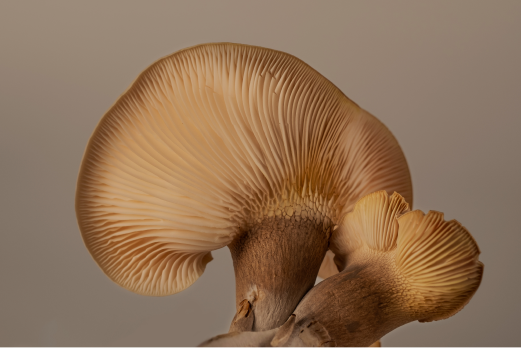
Did you know that long before trees inhabited the land, our planet was covered with enormous mushrooms? In this article, we explore the evolution of mycelium, from fungi to the future of living.
In this article
Mycelium 101
In simple terms, mycelium is the underground strucuture of mushrooms. This can be used to produce everything from furniture to bricks, plastic, packaging, fashion items and even foods! To get a better understanding of what mycelium is and where it comes from, let’s take a quick look at some interesting facts about it.
History has it that thousands of years ago, one honey-fungus species, called Armillaria solidifies, released spores that settled in what we now know as Oregon. Once the spores started to spread, they never stopped, simply because they were "just extremely, extremely successful at growing”, said Adriana Romero Olivares - mycologist at New Mexico State University, in an interview with The Atlantic. The fungus also got extremely large, and now it inhabits about 2,400 acres of earth, which is the equivalent of 1,800 football fields.
Dubbed the Humongous Fungus, the structure is the world's largest living organism and the biggest ever recorded by area on a land. The Humongous Fungus is a complex, flexible and tireless organism that may theoretically have "indefinite growth potential", stated Mee-Sook Kim - research plant pathologist at the U.S. Forest Service, during the afore-mentioned interview with The Atlantic. "As long as you have trees, then this fungus will thrive”, Mee-Sook Kim continued.
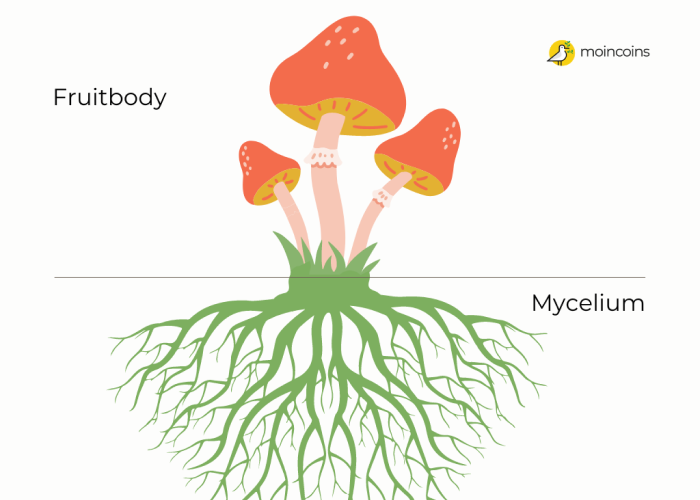
What Mycelium Is
The fungus spreads slowly, just about 0.7 to 3.3 feet per year, and builds mats of fungal matter under the bark, known as mycelium. Mycelium looks like yeast but, unlike yeast, which grows as a single cell, mycelium is multicellular and can develop into macro-size structures, such as mushrooms. Mycelium produces tiny molecules and assembles them into complex structures that are invisible to the human eye. Mycelium can be found in fields, forests, and heavily wooded areas.
Why Is Mycelium So Important?
Well, in 2014, an odd-looking building started taking shape outside the Museum of Modern Arts (MoMA), in New York. It almost looked as if someone wanted to build an igloo, but got carried away and ended up with a bunch of circular towers.
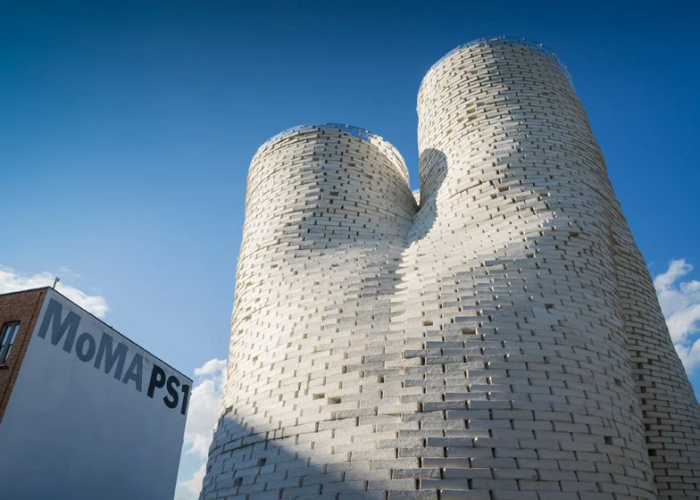
The Hy-Fi Installation
Image credit: Dezeen
Designed by David Benjamin, Principal of The Living and Associate Professor at Columbia GSAPP, the Hy-Fi installation was made entirely from biodegradable materials, such as corn stalks and mushrooms. It took 10,000 bricks to bring the installation to life, all of which have been grown rather than manufactured. Each brick consisted of a mix of agricultural byproducts and mycelium, which worked like a “natural digestive glue”. After that, the bricks were placed together in molds and left to biologically cement through fungal growth.
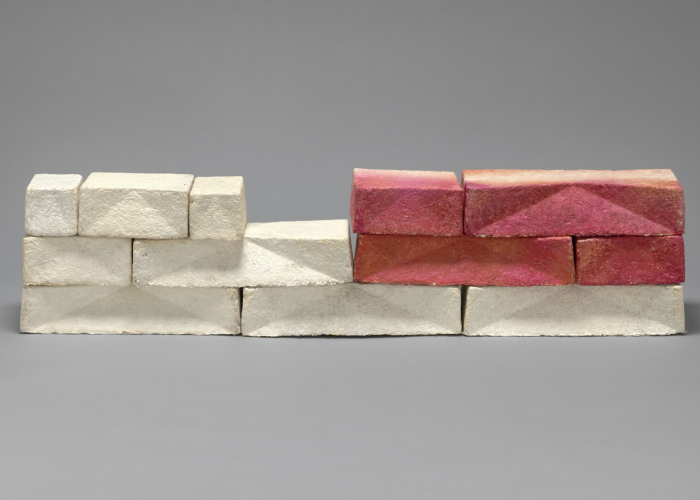
Mycelium brick
Image credit: MoMA
When used in a structure, mycelium bricks have the ability to temporarily divert the natural carbon cycle to produce pieces of architecture that simply grow out of nothing but earth and return to nothing but earth. There is no waste, no energy, and no carbon emissions. This “low-tech biotech” breakthrough that took place in 2014 was a turning point in history that proved that the future could be made of something other than conventional “bricks and mortar". Thanks to its incredible versatility, mycelium can be used in numerous cases, whether you’re looking for unique interior design pieces, a more eco-friendly alternative to meat, vegan gelato and even fashion accessories. Below, we'll take a closer look at how mycelium can be molded to fit all of these industries.
Mycelium in Action
Mycelium Architecture and Design
The way we build nowadays harms the environment and causes significant damage to natural resources, agriculture, and human health. Construction projects emit massive amounts of carbon dioxide and methane and contribute to 23% of air pollution, 40% of drinking water pollution, and 50% of landfill waste. The construction sector is also one of the biggest exploiters of resources and half of those are non-renewable, so looking for more eco-friendly alternatives is crucial.
To make ambitious environmental goals in the construction industry come true, exploring uncommon materials is a must. Mycelium is an extremely versatile material and a suitable option when building with the future in mind. It grows in temperature-controlled and humidity-controlled conditions and can be molded into any given shape.
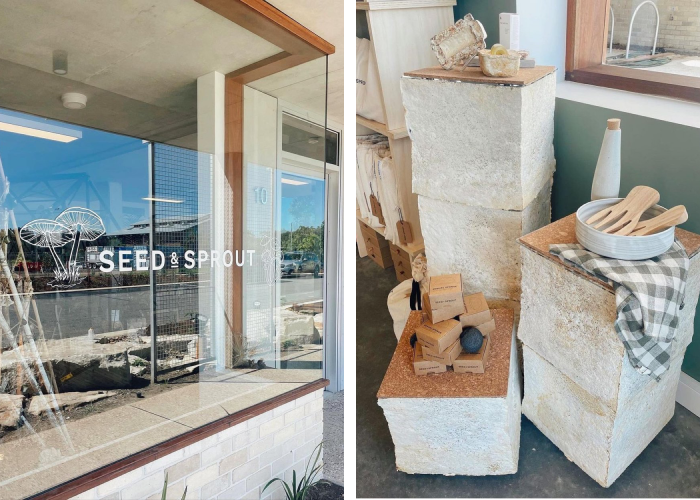
Seed Sprout Mycelium Pop-Up Store
Image credit: Habitat
“Basically, it's a material we can grow into different shapes. We are exploring furniture, building materials, interior linings, and insulation", said Canhui Chen, Swinburne's Lecturer of Architectural Design in an interview with The Green List. Chen also worked with Seed & Sprout, an Australian brand offering innovative eco-friendly products, on a mycelium pop-up store, in Byron Bay. The pop-up store aimed to offer a functional alternative to conventional materials used in retail stores, with everything made entirely from mycelium, such as seating to lighting to display units.
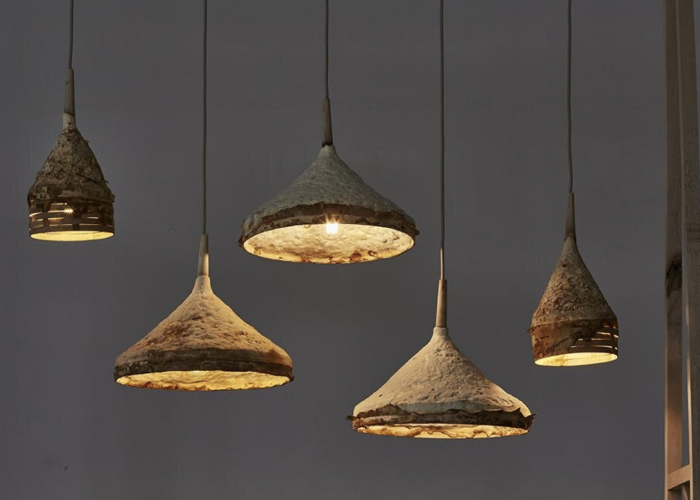
Mycelium Ceiling Pendants
Image credit: Sebastian Cox
Similarly, British designer Sebastian Cox partnered up with researcher Ninela Ivanova to further investigate mycelium’s potential in furniture design and brought to life a series of state-of-the-art lighting pendants. Grown entirely from mycelium, hazel and goat willow, harvested in Kent, UK, the pieces are sustainably manufactured and 100% compostable.
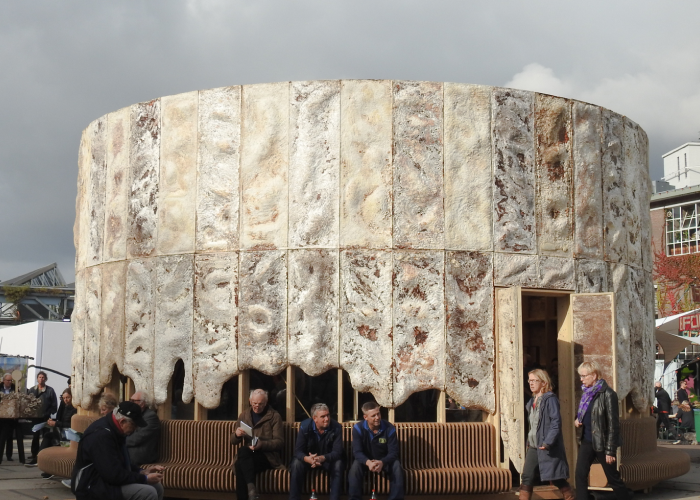
The Growing Pavilion
Image credit: The Growing Pavilion
As its name implies, the Growing Pavilion is another example of how mycelium can be turned into magical, self-growing things. Designed by set designer and artist Pascal Leboucq in partnership with Eric Klarenbeek's studio Krown Design, the temporary structure was built for Dutch Design Week 2019.
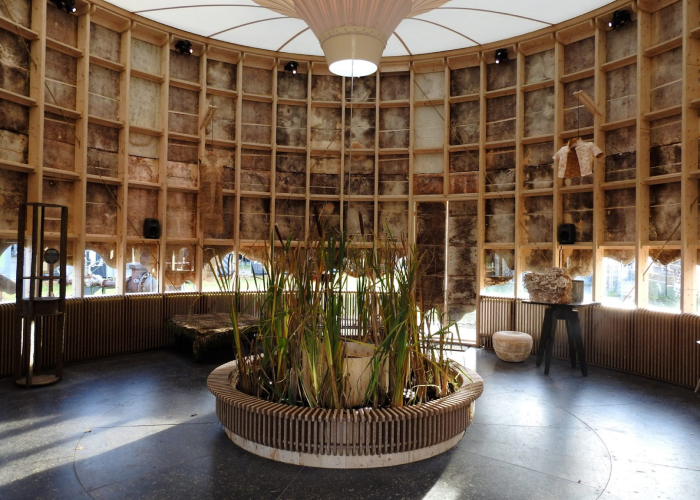
The Interior Of The Growing Pavilion
Image credit: Dezeen
The Growing Pavilion was made up of five raw materials: wood, mycelium, agricultural residue, cattail and cotton and stood as a feasible solution for limiting the use of fossil fuels and its impact on the environment. The mycelium panels were thin but very well insulated in terms of temperature and sound. Each of them has been repaired or reused somewhere else once the structure was taken down.
Mycelium-Based Food
Food production and processing in developing countries cause significant waste and byproducts, which negatively impacts the environment. Today, we consume and produce meat more than ever before. Every year, 65 million animals are slaughtered for meat, and the demand for meat increased in the past 50 years, as countries get richer and the populations grew.
It is becoming apparent that without a serious change in the way we make the food we consume, things will only get worse. Because of this, vegan meat alternatives grew in popularity over recent years. According to The Good Food Institute's research on plant-based meat, producing it requires 72-99% less water and 47-99% less land compared to real meat. It also causes 51-91% less water pollution and 30-90% less greenhouse gas emissions. By switching to plant-based meat alternatives, we could use fewer resources and enable biodiversity to recover and thrive
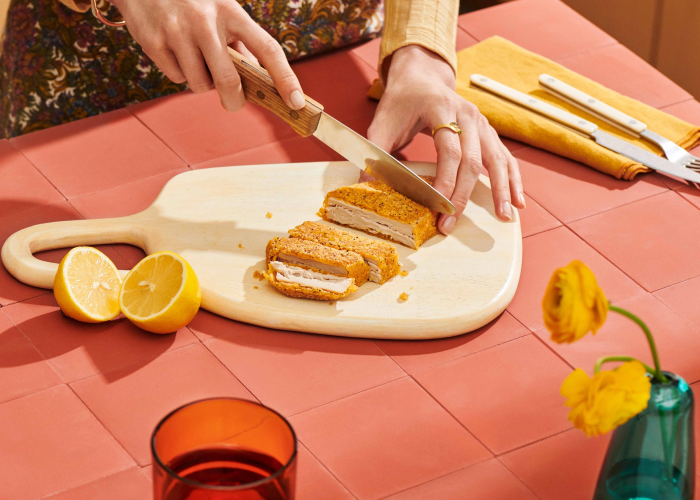
Mycelium-based meat
Image credit: Meati
Meati is an American company turning mycelium into more beneficial meat replacements for consumers and the planet. "About 2 ounces of this gives you 50% of your protein; 50% of your fiber; and half of your daily zinc. There really is nothing that can compare to this product in terms of nutritionals” said Tyler Huggins, Co-founder, in an interview with TechCrunch.
Similarly, MyForest launched MyBacon - a meatless mycelium bacon that looks just like the real thing and tastes “so good, you’ll double-check the label to make sure it’s not meat”. This New York-based company uses farm-grown mycelium that’s free from preservatives, gluten, dairy and soy.
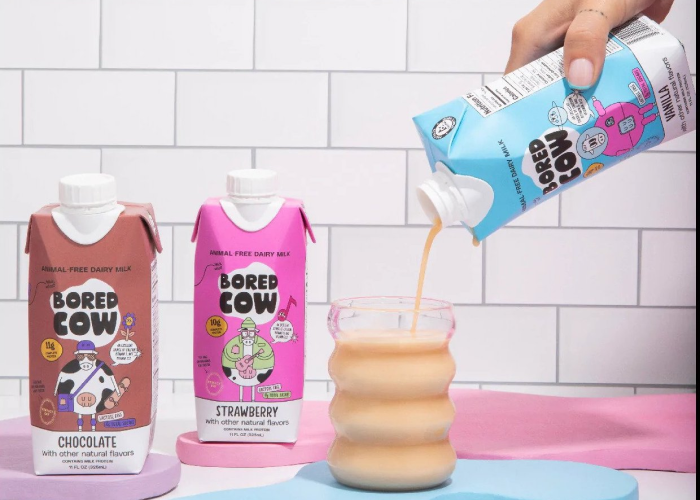
Mycelium-based milk
Image credit: Bored Cow
And if mycelium-based meat hasn’t convinced you yet, then maybe you should give mycelium milk and gelato a try! Perfect Day created fungus-based dairy products made from the same proteins as cow milk, but without the cow.
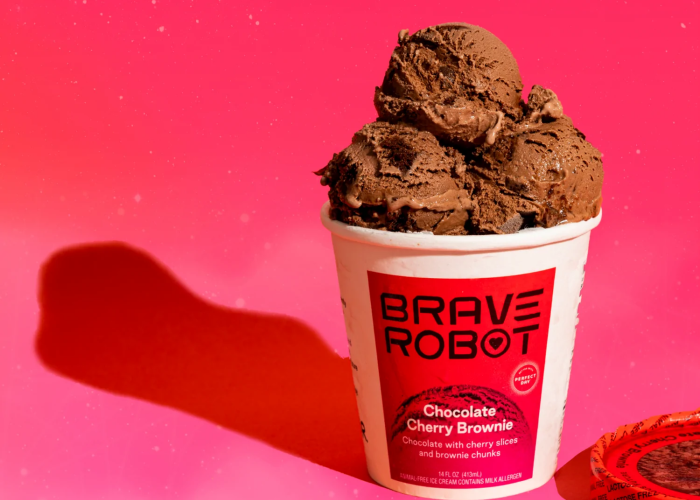
Mycelium-based ice-cream
Image credit: Brave Robot
These are made by fermentation (and a little bit of high-tech bioengineering). Artificial casein and whey genes that are usually found in milk are mixed with a fungus that thrives on plants’ sugars. The production process is 100% animal-free and the end product “has identical taste and texture to cow's milk, but packs in more nutrition with no food safety or contamination concerns”, said Ryan Pandy, Co-founder of Perfect Day in an interview with Digital Trends. Who ever thought that fungi could be so fun?!
Mycelium Fashion
That the fashion industry contributes to the worsening of the climate crisis is no news. Despite all the statistics on how wearing second-hand pieces or producing items from natural fibers and recycled materials could help the environment, customers will always choose convenience.
The real-versus-faux-leather-and-fur debate has been going on for ages and a clear answer is not easy to find. While fake leather is usually plastic-based and non-biodegradable, genuine leather manufacturing processes involve practices of cruelty against animals, the use of multiple toxic chemicals and dyes, massive amounts of water, as well as the cutting down of rainforests.
The answer lies somewhere in between and the good news is that several designers have already cracked the code to a more considerate future for the fashion industry.

Reishi Fine Mycelium
Image credit: Reishi
Patented by artist and co-founder of MycoWorks, Phil Ross, Reishi is the world’s first Fine Mycelium™- a vegan alternative to genuine leather, made from mycelium. Reishi is a revolutionary new material that provides the same quality and performance of the finest animal leathers, but with a much lower environmental impact. The material “looks, feels, and even smells like leather” and offers unprecedented freedom for customization.
It is essential to note that Fine Mycelium is not mushroom leather. Instead, it is a material science and biotechnology breakthrough that is controllable, engineerable, and durable, with a living quality matched only by traditional leather. Unlike mushroom leather, which is made by compressing mycelium’s natural layers of foam into a sheet, producing Fine Mycelium requires a lot more care and precision. Fine Mycelium is made by orchestrating the mycelium cells as they grow to assemble cellular structures that are densely entangled and naturally strong.
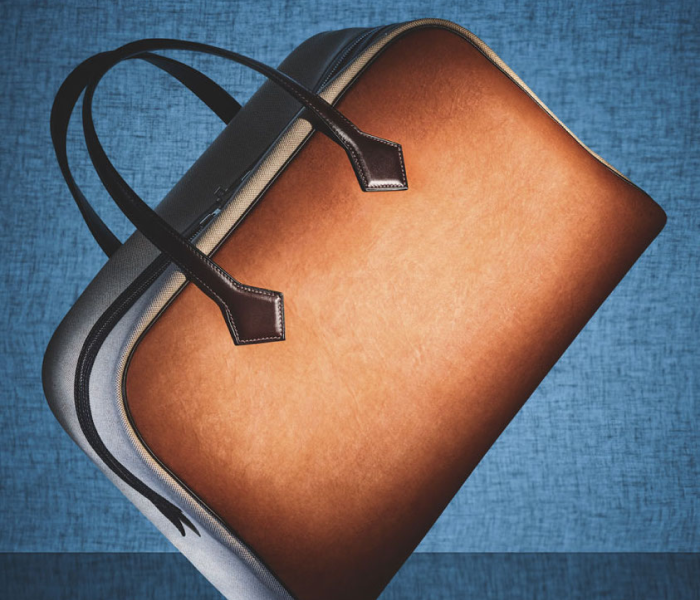
Hermès’ Mycelium-Made Victoria Shopper Bag
Image credit: MycoWorks
Because of Reishi's exquisite quality, pebble finish and natural patina, collaborations with world-famous fashion brands came as no surprise. In 2021, French luxury house Hermes worked with MycoWorks to redesign its Victoria shopper bag using materials grown from mycelium. Called Sylvania, the material MycoWorks developed with Hermes, was the result of a three-year collaboration between the two and served as a reminder that mycelium-made leather is suitable for commercially available luxury products.
Ecovative, a New York-based sustainable materials company, launched pure mycelium hides, called Forager™. These are 100% vegan, have naturally high tensile strength and tear resistance that are equal to genuine leather. Forager can be grown in only nine days and can have up to 27 meters in length and two meters in width. Ecovative’s mycelium leather is produced in vertical farms, which causes considerably less waste than other production methods.
Forager is already being used by fashion brands, such as Reformation, Wolverine, PVH and Bestseller.
Mycelium Beauty
It is no surprise that the Covid-19 pandemic shifted the skincare and beauty market. Data gathered by Kantar in its 2022 Global Report on the beauty industry reveals a dramatic decline in the weekly use of cosmetics, as consumers opt for simpler routines. The study also shows the increased interest in premium beauty products, alongside a growing demand for natural, more eco-friendly products, which rose from 18% in 2017 to 24% in 2021.
"The interest in plant-based ingredients is forcing a deeper discovery into non-chemical counterparts that are just as effective”, noted Regan Schneider, a food scientist and the founder and CEO of beauty brand Arêmês Fermentis in a conversation with Coveteur. Mushrooms are now extensively used across the skincare industry for their potent, natural ingredients. For instance, kojic acid in shiitake can replace hydroquinone for hyperpigmentation, while snow mushroom works just as well as hyaluronic acid for moisture retention.
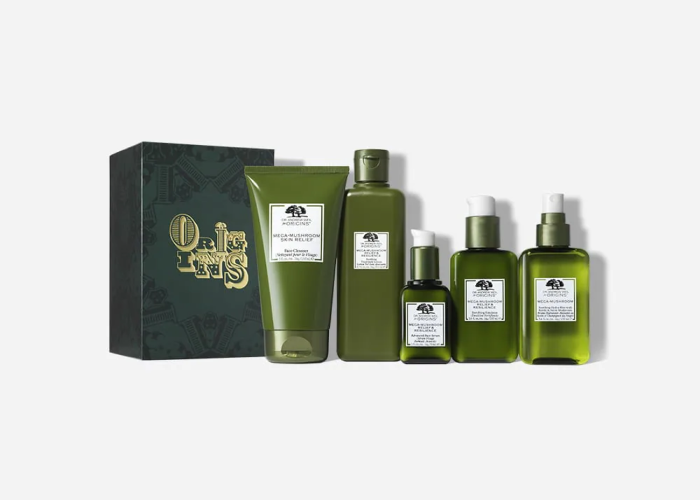
Origins' Mega Mushroom Line
Image credit: Origins
For instance, American cosmetics brand Origins partnered up with Dr. Andrew Weil, an integrative medicine expert, to launch the Mega-Mushroom line, a collection of skincare products aimed at reducing inflammation. The line included formulas packed with a blend of mushrooms, such as fermented chaga, reishi mushroom, cordyceps, and coprinus which can protect the skin from free radicals, soothe inflammation and support cellular energy.
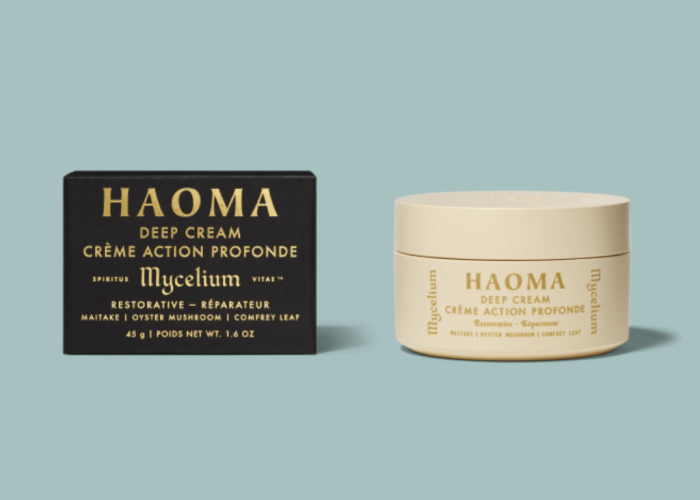
Haoma's Mycelium Collection
Image credit: Haoma
Another American brand tapping into the potential of mycelium is Haoma. Its Mycelium Collection provides long-lasting hydration at a cellular level and utilizes the healing powers of mycelium to penetrate deep into the layers of the skin. Infused with maitake and oyster mushroom extracts, Haoma's Mycelium Collection helps heal inflammation, increases skin elasticity and encourages new cell growth.
Mycelium Packaging
Considering the numerous applications of mycelium, packaging could not have been missed from this list! Mycelium is an optimal packaging solution thanks to its biodegradable, unwasteful nature.
When shipping products from one side of the world to another, ensuring their safety is key. More often than not, plastic-based packaging is preferred for such tasks because it is lightweight and flexible. However, polystyrene packaging causes serious damage to the planet, as it takes hundreds of years to decompose in a landfill. One of the first global companies to recognize that was the Swedish-born furniture company, IKEA.
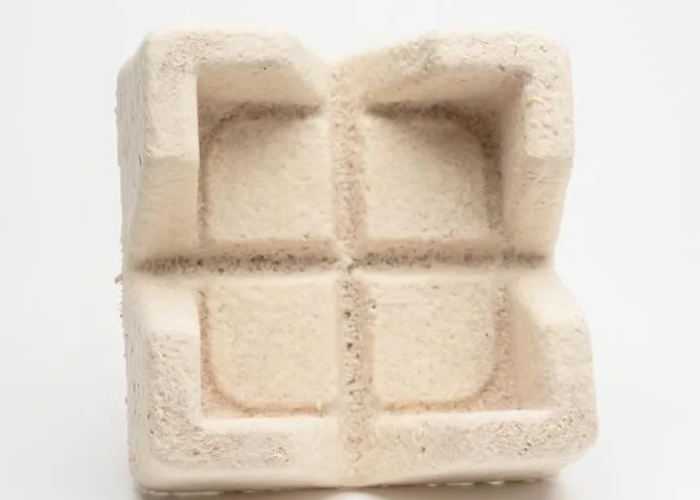
IKEA's Mycelium-Based Packaging
Image credit: Yahoo
Created in partnership with Ecovative, KEA’s mycelium-based packaging is called Mushroom Packaging, or MycoCompositeI. The material is grown in less than a week by combining agricultural products with mycelium and sealing them up in a controlled environment. During the process, the fungus grows around the products and fills the empty spaces within the mold. Once the material has taken shape, it will be heat-treated to dry out, remove spores and completely stop the growth process.
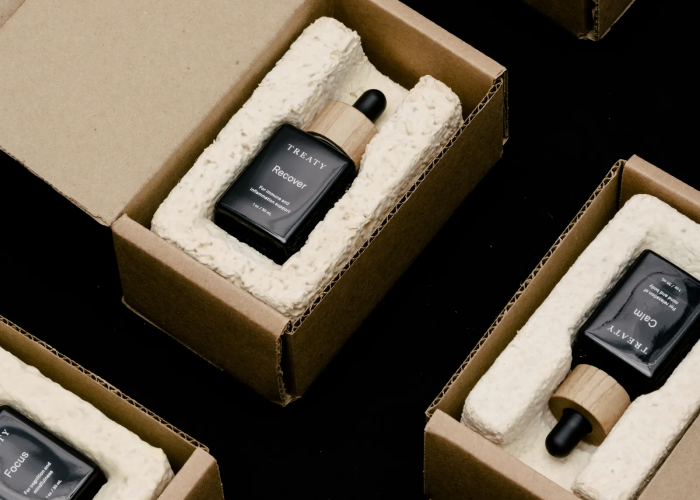
Hudson Hemp's Mycelium Packaging
Image credit: Vogue
Another brand that jumped on the mycelium packaging bandwagon is Hudson Hemp, an American farm and CBD company based in the Catskill mountains. The company's Co-founder, Melany Dobson said that they decided to integrate mycelium into their packaging solutions because it was convenient. Her team grows hemp, alongside other grains that supply flour to local bakeries, livestock feed for dairy farms and cereals for brewers and distillers. Part of Hudson Hemp’s purpose is to generate soil that relies on nutrients provided by the farm itself and since mycelium is all about soil health, they decided to go for it. The company started collaborating with Ecovative in 2019, and all Hudson Hemp CBD has been shipped in custom-made Ecovative packaging ever since.
What is the Downside of Mycelium?
When it comes to turning fungi into commonly-used items, like handbags, shoes or even foods, several questions might arise. Sure, skepticism is an understandable reaction to such alien developments, but the truth is that we should embrace this concept with an open mind.
For instance, mycelium-based meat is made of 95% mushroom root, is packed with proteins, fibers and essential nutrients found in animal meat, such as iron zinc and B vitamins. Also, the texture of mycelium-based meat is extremely similar to muscle tissue, which means that it's easy to turn it into any shape, texture and flavor.
Similarly, caring for mycelium leather goods is as easy as caring for products made of genuine leather. All you need to do is wipe with a soft cloth and store it in a dust bag or a shoe box. Also, unlike other vegan leathers, which usually have a polyurethane coating, mycelium leather produced by Mylo are not petroleum-based. All of its processing and finishing are analyzed and selected based on Green Chemistry principles.
One of the downsides of mycelium leather is that it’s challenging and expensive to make. Making it readily available at a larger scale where every customer can enjoy it, regardless of their budget is something that companies such as Mylo or MycoWork are still working on. Even though this might take a few years, we're excited to know that the future will be a little more eco-friendly.
Moincoins' View on Mycelium
If we were to make a list of the pros and cons of integrating mycelium into people's lives, we believe the former list would overwhelm the latter! It is not very often that we say that, but after doing some extensive research on mycelium for the past weeks, we must admit that it's a truly revolutionary material.
From its seamless integration into the fashion industry and architecture to skincare products and even ice cream, mycelium seems to be one of the most accurate representations of what life might look like in the future. Even though building large-scale apartment complexes entirely of mycelium is still a work in progress, we are excited to see what other realms of living this fungi can spread to.
Other Things to Keep in Mind About Mycelium
Can I Grow My Own Mycelium?
Yes, you can! Growing mycelium is a cool thing to do since it sparks your imagination and, who knows, it might even turn you into the world's next big mycelium inventor! Check out Grow.bio to get a Grow-It-Yourself Mushroom® kit. Beware that this is science and the process can get difficult and require some trial and error before getting it right.
Is it Expensive to Make Things From Mycelium?
Generally speaking, making objects out of mycelium is inexpensive because fungi is cheap. According to Canhui Chen, Swinburne's Lecturer of Architectural Design, you can replicate it as long as you have time, patience and skill. From one spore you make as much as you want. You can use organic waste that's rubbish, so it's cheap. It's only expensive through the labor involved.
However, making mycelium-based leather is an entirely different process that can be expensive and time-consuming. Because of this, goods made from mycelium leather tend to be more expensive than those made of genuine leather, but manufacturers are currently working on a process that will enable them to produce it at a comparable price to leather hide.
Can Mycelium Packaging Be Recycled?
Packaging made from mycelium is fully biodegradable and can compost in 45 days. All you need to do is to tear the packaging into tiny pieces and place them into your compost bin or even into your gardening soil. Once moisture and microbes come close to it, they’ll take care of the rest.